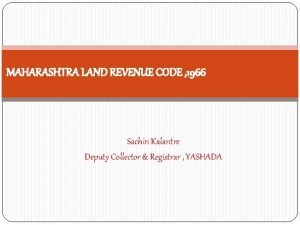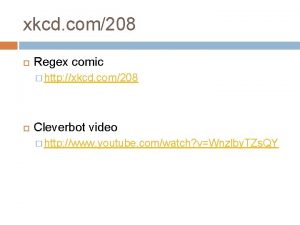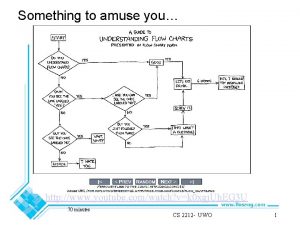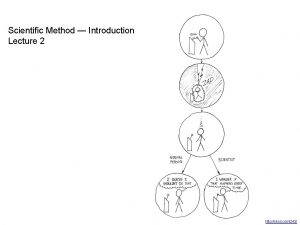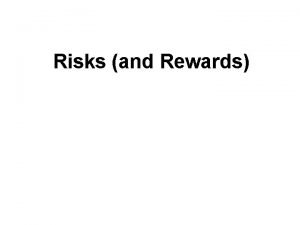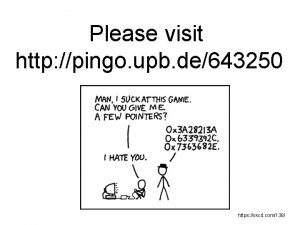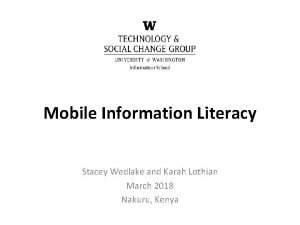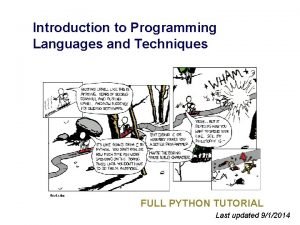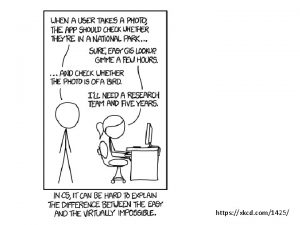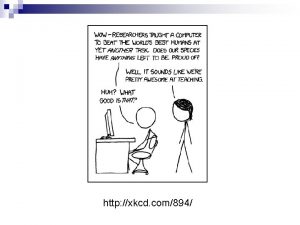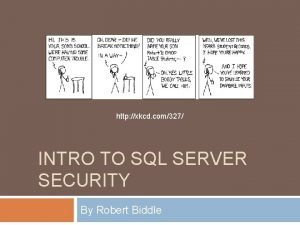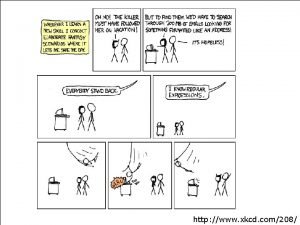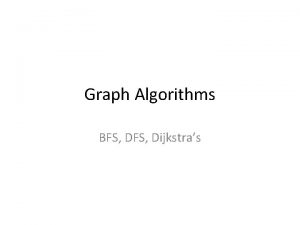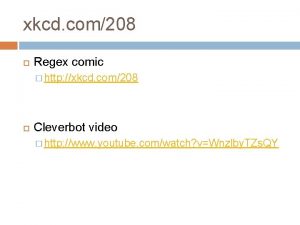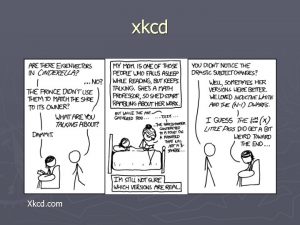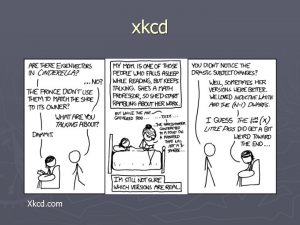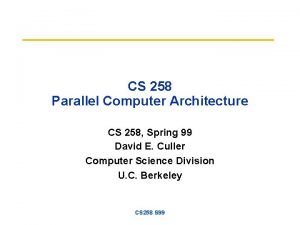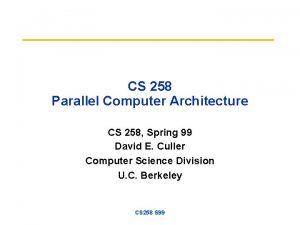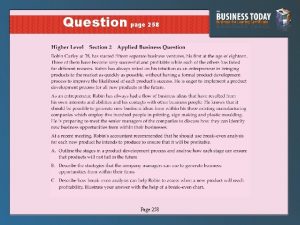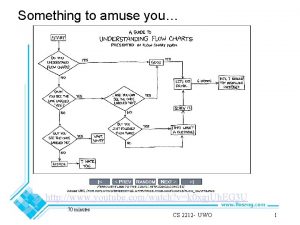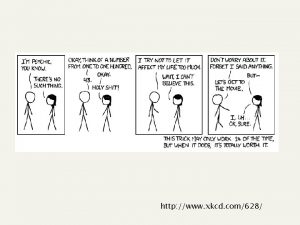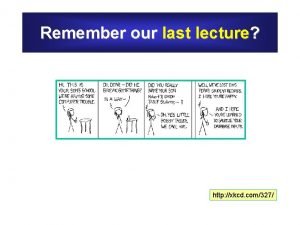http xkcd com844 1 MI 258 Class 01

























- Slides: 25

http: //xkcd. com/844/ 1

MI 258: Class 01 Introduction: Why System Design? Overview of the Course Slides based in part on materials included with Applying UML and Patterns: An Introduction to Object-Oriented Analysis and Design and Iterative Development. 3 rd Edition Craig Larman. Prentice-Hall PTR, 2005. Copyright © 2005 by Craig Larman. All rights reserved. MI 258 2

Systems Analysis & Design • • • ? s – For gathering requirements hi t – For representing requirements l l a – For representing design decisions d A methodology (design process) e e n – Specifies which techniques & diagrams to use e – Coordinates the development activity w A setoof tools D A set of techniques (& diagrams) – Use technology to automate and enhance the design process MI 258 3

Discussion • Why do we need systems analysis and design? • What problems does it solve? • What techniques does it use? MI 258 4

Source: Computerworld MI 258 5

It’s Hard Out There for a Software Developer • Jaguar Software Issue May Cause Cruise Control to Stay On • Blackberry Outages Spread to North America • Ariane 5 rocket lost due to software error • FBI scraps $170 M Virtual Case File project • More Recently MI 258 6

Some Scenarios • Missing or incorrect requirements • Unmanaged risks – Technology risks (performance, battery life, etc. ) – Other risks MI 258 7

What Makes Software So Tough to Create? • Complexity – Many tightly coupled components • Conformity – Must conform to (arbitrary) external requirements • Changeability – Requirements and technology change constantly • Invisibility – Software structures are internal states of a computer and hence difficult to observe directly MI 258 8

Why Software Fails (Charette, 2005) • Unrealistic/unstated goals • Inaccurate estimates • Badly defined requirements • Poor status reporting • Unmanaged risks • Poor communication • Immature technology • Project complexity • Sloppy development practices • Poor project management • Politics • Commercial Pressures MI 258 9

One Response: Systems Analysis & Design • A set of tools and techniques to help software developers cope with the complexity inherent in designing complex systems • Question: what other complex systems might benefit from such tools? MI 258 10

Overview of the Course MI 258 11

Course Goals • Learn to identify an organization’s information processing requirements. • Learn to develop a detailed specification for an information system. • Understand how to leverage understanding of organizations, culture, organizational change, and business processes. • Understand that IT strategy must align with organizational strategy. MI 258 12

Techniques & Methods • Diagrams: Unified Modeling Language (UML) – a visual language for describing information systems. • Software Tools – Canvas. Course website and collaboration tool. – Lucidchart. A web-based diagramming tool. – APEX. Web development framework (Oracle). • Methodology: The Unified Process (UP) – Industry standard object-oriented development methodology. MI 258 13

Course Roadmap (Highlights) • • • Use Cases Process Modeling System Sequence Diagrams Class Diagrams Interface Design Interaction Diagrams MI 258 14

Course Materials • Applying UML and Patterns by Craig Larman • Making I/T Work by Dennis Severance and Jacque Passino • Case: 1 -888 -Junk-Van. Purchase online. • MI 258 Online Reserves. Accessible from Canvas. MI 258 15

Course Grading Class reflections 10% Reading responses 10% Class Participation 10% Midterm 10% Final 10% Project 50% TOTAL 100% MI 258 16

Team Evaluations • Grades adjusted based on consensus of team on significant differences in contribution • Downward adjustment only for "absolute" shirking • Evaluations on process and product will be filled out confidentially at end of semester MI 258 17

Course Website – Canvas • Will replace Black. Board at BC • We are part of a “pilot project” • Advantages – Modern interface – Integration with other tools (e. g. Calendar) – Calendar of all upcoming assignments (across all courses) – Better tools for collaboration and communication MI 258 18

Getting Started with Canvas • Set notifications (for due dates, grading, announcements, etc. ) • For overview see Calendar or Course Home Page • Each Lecture “activity” on calendar will include detailed notes and links • All assignments are posted and submitted via Canvas • Teams will each have a group workspace MI 258 19

Use of Electronic Devices • Treat this as an important business meeting in which you are highly visible • Consideration for others • Avoid distractions • Impact on class participation grade • Demand an engaging environment MI 258 20

Disability Services If you are a student with a documented disability seeking reasonable accommodations in this course, please contact Kathy Duggan, (617) 552 -8093, dugganka@bc. edu, at the Connors Family Learning Center regarding learning disabilities and ADHD, or Paulette Durrett, (617) 552 -3470, paulette. durrett@bc. edu, in the Disability Services Office regarding all other types of disabilities, including temporary disabilities. Advance notice and appropriate documentation are required for accommodations. MI 258 21

Academic Conduct • Please adhere to the School’s Code of Academic Conduct • If in doubt, get clarification from instructor MI 258 22

Team Formation: Key Skills • • Project Management Database & Programming Writing Visuals MI 258 23

Team Formation Process • Four interests Four corners – TAs will represent missing students • Balance the corners • No best friends or worst enemies • Each team: write your team number and membership on the board • Now forget which corner you were in (no preassigned roles) MI 258 24

Team Assignment: Find a Client • Details on Canvas • Will put you in Teams on Canvas by tomorrow • Will ask you to also do a progress report next week (our no class week) MI 258 25
 258x203
258x203 Section 258 of mlrc
Section 258 of mlrc Emily dickinson 258
Emily dickinson 258 The verbs ser and estar (p. 258) answers
The verbs ser and estar (p. 258) answers Via cavour 258 roma
Via cavour 258 roma Rd 258/99
Rd 258/99 Gog 258
Gog 258 Http //mbs.meb.gov.tr/ http //www.alantercihleri.com
Http //mbs.meb.gov.tr/ http //www.alantercihleri.com Http //pelatihan tik.ung.ac.id
Http //pelatihan tik.ung.ac.id Regex xkcd
Regex xkcd Xkcd flowcharts
Xkcd flowcharts Xkcd scientific method
Xkcd scientific method How to hack pbis rewards
How to hack pbis rewards Xkcd recursion
Xkcd recursion Xkcd
Xkcd Xkcd coding
Xkcd coding Clsafetycheck.org
Clsafetycheck.org Xkcd #619
Xkcd #619 Analogizers
Analogizers Xkcd
Xkcd Xkcd neural network
Xkcd neural network Sql injection xkcd
Sql injection xkcd Xkcd drop tables
Xkcd drop tables Xkcd sql
Xkcd sql Www.xkcd.com
Www.xkcd.com Xkcd breadth first search
Xkcd breadth first search

